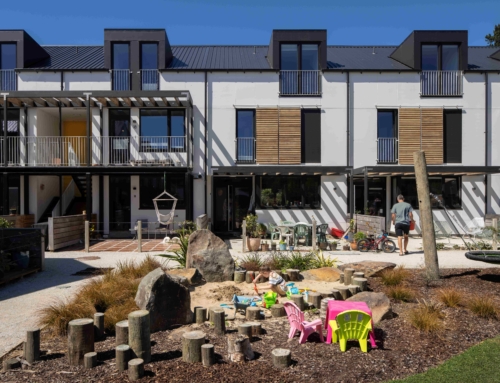Introduction to Cohousing
by Judy Shepalo
The History of Cohousing
Cohousing is a concept that came to North America in 1988 from Denmark where it had emerged in the early 1960s. It describes neighbourhoods that combine the autonomy of private dwellings with the advantages of shared resources and community living.
In 1989, the first North American cohousing community arrived in Davis, California. In North America at present, approximately 160 cohousing communities have been completed since 1991. Currently, there are more than 100 new communities in various stages of development. The level of social interaction and shared resources varies among communities.
What is Cohousing?
Cohousing is an intentional community for individuals who decide to live in privately owned homes yet share common indoor and outdoor spaces, activities and various aspects of their lives. Many boomers looking for alternative living arrangements are looking for innovation, freedom from isolation and assurances of personal safety. Accordingly, these individuals prefer to live in communities that support aging in place.
What to Expect
In a cohousing community, each resident’s home has a kitchen and other typical amenities. The community’s common house usually has a large kitchen, dining area, recreational space, a laundry room and guest suite. Part of a growing movement, residents find it an efficient way to live; they own real estate in common, benefit from economies of scale and share appliances, tools, bikes, guest suite etc so that each household owns less stuff.
Cohousing provides smaller dwellings, collective decision making and equitable access to community-owned property. As a result, it’s fun, eco-friendly and sociable, providing opportunities for lifelong relationships, shared activities, mutual support, co-care and safety.
The spirit of giving back and reciprocity are primary with cohousing communities. Daily, weekly and monthly chores are shared, enriching community life for all. Moreover, recruiting younger seniors into cohousing is encouraged to diminish the likelihood that most residents may need assistance simultaneously and to have an intergenerational sharing of work responsibilities.
How Does it Work?
What makes cohousing work for many is the fact that residents participate in the planning, design, ongoing management and maintenance of their community, meeting frequently to address each of these processes. Cohousing neighbourhoods tend to offer environmentally sensitive design with a pedestrian orientation.
Who is Involved?
They typically range from 10 to 35 households and can be comprised of older adults and seniors starting at age 50, or a multi-generational mix of singles, couples, families with children, older adults and seniors. A cohousing development seems limited only by the imagination, desire and resources of the group of people who are actively creating their own neighbourhood.
Why Choose Cohousing?
Overcoming Fear of Change
Some may find the prospect daunting. However, as author Stephen Covey says,
“One of the worse things you can do to your own well being and growth is to stereotype yourself, ‘Oh, that’s not for me,’ or ‘I couldn’t do that’.”
Fear of change and self-imposed social restraints keep many from considering cohousing as an alternative to traditional housing models. However, traditional models (retirement residence, condo, apartment, staying in one’s own home) can be restrictive and/or isolating over time.
Alternatively, cohousing designed for older adults and seniors offers opportunities for aging together not normally seen in senior housing, including the ability to respond more effectively to the evolving needs and desires of older persons.
Addressing Our Concerns
Choosing how and where to grow old is an integral step in taking control of one’s future. Cohousing is a way to address aging concerns. Residents can remain productive, access caregiving resources, escape loneliness and live independently at home for as long as possible. Although choosing cohousing isn’t “normal”, it’s smart. Sometimes we have to make choices that are the best for us, even if they aren’t the easiest thing to do.
People will argue they need their privacy but everyone values privacy; it’s a basic human need. Co-housing neighbourhoods are designed so that residents balance privacy and community by choosing their own level of engagement. It’s a reconceiving of community where we stop boxing ourselves into narrow parameters and face our realities.

Choosing Fun!
Getting old doesn’t have to be a wholly negative experience. Seniors are increasingly valuing health and fun and are choosing cohousing as a model that embraces this environment.
Charles Durrett is an architect who lives in cohousing in northern California. He helped introduce the concept to North America in the 1980s and says,
“We are all stewards in the ebb and flow of our living landscape which allows us to know, therefore care, and therefore support each other without hindering my life of theirs. To learn to grow old together is a natural part of life, more of a freeing experience than an encumbering one.”
Having a good time as you age is no accident – it’s a lifestyle choice.






